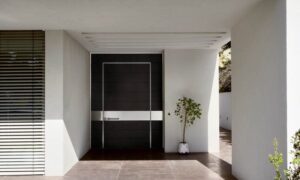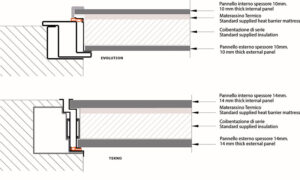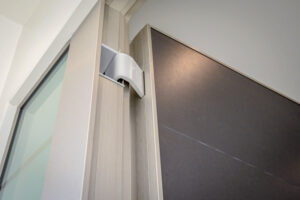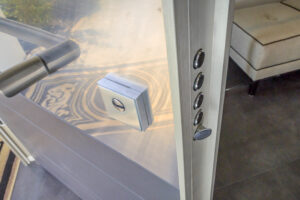Choosing the right front door means finding a balance between durability and style. A well-made entry door should withstand wind, rain, and harsh sunlight while also providing security and enhancing curb appeal. However, not all doors meet these demands.
In this guide on how to choose a front door, we’ll explore the pros and cons of different materials and share key insights to help you choose the best entry door system for your home.
Why Your Front Door Matters
The front door is the first and last thing your guests will see, so you want it to make an impression. Staying on top of front door trends ensures you not only enhance curb appeal but also improve the functionality of your home. It’s also a great investment for your home: an energy-efficient door can save you 10% on your energy bill, and on average you’ll recoup nearly 100% of the cost on resale. If you’re looking for renovation projects to spruce up your home, upgrading your front door is a great place to start.

When following a front door buying guide, it’s essential to consider how the color complements the overall style and aesthetic of your home. Home entry doors are often referred to as door systems because it’s not just the door you’re buying, but the frame (see insulation below) and locking mechanism as well. Home entry doors are often referred to as door systems because it’s not just the door you’re buying, but the frame (see insulation below) and locking mechanism as well. Home entry doors are often referred to as door systems because it’s not just the door you’re buying, but the frame (see insulation below) and locking mechanism as well. The standard pre-hung front door is 30–36 inches by 80 inches. There are plenty of options available if you have a standard size front door, but if not, you’ll save a lot of time and headaches ordering a custom front door—Oikos front doors with a pivot hinge are available up to six feet wide and 11 feet tall! Custom front doors are nearly always made from a palette of modifications available for standard door design.
Types of Front Doors
Understanding how to choose a front door involves considering factors like durability, security, energy efficiency, and aesthetics. Leading brands like Jeld-Wen, Masonite, and Pella offer entry doors in various materials, each with distinct advantages depending on your budget, climate, and design preferences.
Fiberglass
Fiberglass doors are a popular choice for homeowners seeking durability, low maintenance, and design versatility. Available in smooth finishes or wood-grain textures, they closely resemble real wood.
- Pros: Resistant to warping, cracking, or rusting, fiberglass doors offer excellent insulation and require minimal upkeep. They can be painted or stained, are dent-resistant, and fall within a mid-range price point.
- Cons: While sturdy, fiberglass doors may crack under extreme impact, especially in very cold temperatures. Though they resemble wood, they lack its authentic texture and depth.
Steel
For those prioritizing security and affordability, steel doors are a strong contender, making up nearly half the market.
- Pros: Steel doors provide superior security, energy efficiency, and weather resistance. They come in various styles, including options with glass panels, and are the most budget-friendly choice.
Comment
by from discussion
- Cons: Steel doors are prone to dents and scratches, which can lead to rust if not addressed. They may require occasional touch-ups to maintain their appearance, especially in harsh weather conditions.
Wood
If you’re looking for a classic and high-end aesthetic, wood front exterior doors offer unmatched warmth and elegance.
- Pros: Solid-wood doors are highly customizable, resistant to dents, and can be refinished to maintain their appearance. Their rich finishes and intricate paneling enhance curb appeal.
- Cons: Wood doors require regular maintenance to prevent warping, swelling, or cracking due to moisture and sun exposure. They are also the most expensive option.
7 Considerations to Keep in Mind When Choosing a New Front Door
Choosing the right front door is a critical decision that impacts both the appearance and functionality of your home. Not only does it need to complement your style, but it also plays a key role in security, insulation, and overall curb appeal. Whether you’re wondering how to choose a front door or considering custom doors to match your home’s unique design, there are several factors to keep in mind to ensure you make the right choice. Here are 7 essential considerations to guide you through the process.
Start online
Learning how to choose a front door has become easier thanks to online tools that let you visualize different options for your home. Many manufacturer websites now offer 360-degree views of interior doors, customizable finishes, and augmented reality tools to help you picture different models in place. However, there’s no substitute for visiting a store in person to physically inspect an interior door. Even if the exact model isn’t available, feeling and testing similar doors can give you a reliable sense of their construction and finish quality.
Consider energy efficiency
When wondering how to select a front door, consider its energy efficiency. Steel and fiberglass doors generally offer better insulation compared to wood doors because of their dense, insulated cores. Energy Star-qualified models must pass independent testing and certification, usually featuring tighter-fitting frames and advanced weather stripping. For doors with glass, options with low-emissivity (low-E) coatings and double- or triple-pane glass reduce heat transfer, helping maintain a comfortable indoor temperature year-round.


A look inside the construction of an Oikos front door
If you need an extra incentive to choose an energy-efficient door, certain models, including Tekno front doors, may qualify for the federal Energy Efficient Home Improvement Credit, allowing you to deduct up to 30% of the cost of a qualifying door from your taxes through 2032.
Keep in mind that heat loss typically occurs more through air leaks around the door than the door itself. Proper sealing is just as crucial as the door’s insulation value, and since entry doors make up a small portion of a home’s surface area, their impact on overall energy savings might be less significant than other upgrades.
Material
When considering how to select a front door, understanding the different materials available is crucial. Modern entry doors often combine multiple materials to optimize durability, security, and aesthetics.
Wood
Wood remains a classic choice, offering a timeless look with rich textures. It is available in various species, such as walnut, cherry, oak, mahogany, maple, pine, and fir. While solid wood doors provide an elegant appearance, they require regular maintenance to prevent warping and weather damage.

On the left, an Oikos front door with a pivot, and on the right, an Oikos door with hidden hinges
Many modern wood doors feature a veneer over an engineered-wood core to enhance stability and minimize expansion and contraction. When considering how to choose a front door, wood is an excellent option for those who prioritize aesthetics and craftsmanship while being willing to invest in upkeep for long-term durability.
Steel
Steel doors are a top option for homeowners seeking security and durability. Stronger than wood or fiberglass, steel doors resist warping and cracking. Many premium steel doors include a high-density foam insulation core, and some feature a wood-fiber coating or laminated-wood veneer for added style. However, steel doors require proper maintenance to prevent rust.
Fiberglass-composite
Fiberglass-composite doors are popular due to their durability and low maintenance. They resist wear and tear, can mimic the appearance of wood, and perform well in extreme climates. Premium fiberglass doors include polyurethane-foam insulation and long warranties, making them an energy-efficient choice. However, low-quality fiberglass doors may crack under impact. When considering how to choose a front door, fiberglass is an excellent option for homeowners looking for a balance between affordability, durability, and design versatility.
Glass
Glass is an increasingly sought-after material, especially for a modern glass front door. These doors add sophistication and allow natural light to enter while maintaining security through reinforced glass panels. Many modern glass doors incorporate impact-resistant features, ensuring both style and safety.
Aluminum
Aluminum doors offer a sleek, contemporary look with excellent weather resistance. They have an insulated core and a baked-on enamel finish, eliminating the need for repainting. Although aluminum doors are among the pricier options, they provide long-lasting durability and often come with extended warranties.
For those wondering how to choose a front door, it’s essential to balance aesthetics, security, insulation, and maintenance. A high-quality front door, such as Oikos custom front doors, integrates a steel frame with an advanced insulating core and offers customizable finishes like steel, wood, porcelain, concrete, glass, or lacquer. Homeowners can even choose different interior and exterior finishes for a unique, high-performance entryway.
Size
Choosing the right size for your exterior door goes beyond just taking measurements. Some styles, such as front entry and patio doors, may feature double doors instead of a single door, which can significantly increase your costs, as noted by Smith.
To measure for your new exterior door, begin by using a tape measure to determine the width and height of your current door slab. Be sure to round each measurement up to the nearest inch to ensure you get the correct size for your existing frame.
Think about safety
When learning how to select a front door, prioritize safety. A strong lock and reinforced frame are vital for deterring break-ins, as forced entry often occurs by kicking in the door. In our tests with a battering ram, we found that all door materials—fiberglass, steel, and wood—shared a common vulnerability: the doorjamb near the lock’s strike plate.

This Oikos front door has four locking pins
Reinforcing the lock area with a heavy-duty strike plate and quality lock, such as those found on Nova front doors, can significantly enhance the door’s resistance to being kicked in.
Plan for installation
When learning how to choose a front door, it’s important to plan for installation. Most entry doors come prehung in a frame and pre-drilled for a knob and deadbolt, simplifying the installation process. If you’re replacing an existing door with a similar size, this can save time and effort. However, if you’re upgrading to a larger door or adding sidelights, reframing the opening is often required. This is best left to a contractor, as it involves structural modifications.
Most major home stores offer installation or referral services. Even for doors of the same size, professional installation ensures a precise fit and proper sealing, which are crucial for insulation and security. If you’re not an experienced carpenter, hiring a professional could be the best route for a hassle-free installation.
Conclusion
Selecting the perfect front door is a key decision that blends style, security, and energy efficiency. From choosing the right materials to ensuring proper installation, each consideration plays a significant role in enhancing your home’s appeal and functionality. Taking the time to assess your options carefully will ensure you invest in a front door that not only elevates your home’s exterior but also provides lasting value and protection for your family.



